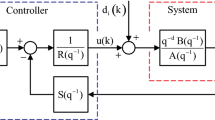Abstract
The paper addresses an approach to robust stabilization of chemical continuous stirred tank reactors. State feedback was used for the stabilization and the feedback controller was designed using the robust model-based predictive control algorithm in which the symmetric constraints on input and output variables are taken into account. The known strategy was modified by adding integral action to the controller. Parameters of robust feedback controllers with and without integral action were found as solutions of a constrained optimization problem solved on the infinite prediction horizon. The possibility to stabilize chemical reactors with uncertainty using the robust model-based predictive control has been verified by simulations and compared with the optimal linear quadratic control and the model-based predictive control. The obtained results confirm that the robust model-based predictive control provides better results than other approaches.
Similar content being viewed by others
References
Alvarez-Ramirez, J., & Femat, R. (1999). Robust PI stabilization of a class of chemical reactors. Systems & Control Letters, 38, 219–225. DOI: 10.1016/s0167-6911(99)00057-2.
Bakošová, M., Puna, D., & Mészáros, A. (2006). Control of a continuous-time stirred tank reactor via robust static output feedback. In Proceedings of the 14th IEEE Mediterranean Conference on Control and Automation, June 28–30, 2006 (pp. 1–6). Ancona, Italy: Università Politecnica delle Marche. DOI: 10.1109/MED.2006.328854.
Bakošová, M., Puna, D., Dostál, D., & Závacká, J. (2009). Robust stabilization of a chemical reactor. Chemical Papers, 63, 527–536. DOI: 10.2478/s11696-009-0046-2.
Bemporad, A., Morari, M., Dua, V., & Pistikopoulos, E. N. (2002). The explicit linear quadratic regulator for constrained systems. Automatica, 38, 407–427. DOI: 10.1016/s0005-1098(01)00174-1.
Boyd, S., El-Ghaoui, L., Feron, E., & Balakrishnan, V. (1994). Linear matrix inequalities in system and control theory. Philadelphia, PA, USA: SIAM.
Di Ciccio, M. P., Bottini, M., Pepe, P., & Foscolo, P. U. (2011). Observer-based nonlinear control law for a continuous stirred tank reactor with recycle. Chemical Engineering Science, 66, 4780–4797. DOI: 10.1016/j.ces.2011.06.038.
Ding, B. (2010). Constrained robust model predictive control via parameter-dependent dynamic output feedback. Automatica, 46, 1517–1523. DOI: 10.1016/j.automatica.2010.06.14.
Favache, A., & Dochain, D. (2010). Power-shaping control of reaction systems: The CSTR case. Automatica, 46, 1877–1883. DOI: 10.1016/j.automatica.2010.07.011.
Flores-Tlacuahuac, A., Alvarez, J., Saldívar-Guerra, E., & Oaxaca, G. (2005). Optimal transition and robust control design for exothermic continuous reactors. AIChE Journal, 51, 895–908. DOI: 10.1002/aic.10345.
Gerhard, J., Mönningmann, M., & Marquardt, W. (2004). Robust stable nonlinear control and design of a CSTR in a large operating range. In Proceedings of the 7th International Symposium on Dynamics and Control of Process Systems, July 5–7, 2004 (pp. 92-1–92-6). Cambridge, MA, USA: International Federation of Automatic Control.
Graichen, K., Hagenmeyer, V., & Zeitz, M. (2009). Design of adaptive feedforward control under input constraints for a benchmark CSTR based on a BVP solver. Computers & Chemical Engineering, 33, 473–483. DOI: 10.1016/j.compchemeng.2008.11.002.
Hoag, H., Couenne, F., Jallut, C., & Le Gorrec, Y. (2011). The port Hamiltonian approach to modelling and control of Continuous Stirred Tank Reactors. Journal of Process Control, 21, 1449–1458, DOI: 10.1016/j.jprocont.2011.06.014.
Kothare, M. V., Balakrishnan, V., & Morari, M. (1996). Robust constrained model predictive control using linear matrix inequalities. Automatica, 32, 1361–1379. DOI: 10.1016/0005-1098(96)00063-5.
Kvasnica, M., Herceg, M., Čirka, Ľ., & Fikar, M. (2010). Model predictive control of a CSTR: A hybrid modeling approach. Chemical Papers, 64, 301–309. DOI: 10.2478/s11696-010-0008-8.
Löfberg, J. (2004). YALMIP: A toolbox for modelling and optimization in Matlab. In Proceedings of the CACSD Conference, September 24, 2004 (pp. 284–289). Taipei, Taiwan: TC-CACSD.
Luyben, W. L. (2007). Chemical reactor design and control. Hoboken, NJ, USA: Wiley-Interscience.
MathWorks (2012). Linear-quadratic (LQ) state-feedback regulator for discrete-time state-space system. Documentation Center. Retrieved October 2, 2012, from www.mathworks.com/help/control/ref/dlqr.html
Mikleš, J., & Fikar, M. (2007). Process modelling, identification, and control. Berlin, Germany: Springer.
Molnár, A., Markoš, J., & Jelemensky, Ľ. (2002). Accuracy of mathematical model with regard to safety analysis of chemical reactors. Chemical Papers, 56, 357–361.
Pólik, I. (2010). Addendum to the SeDuMi user guide, version 1.1. Retrieved October 2, 2012, from http://sedumi.ie.lehigh.edu/
Puna, D., & Bakošová, M. (2007). Robust PI controller design for a CSTR with uncertainties. In Proceedings of the 34th International Conference of SSCHE, May 21–25, 2007 (pp. 043-1–043-10). Tatranské Matliare, Slovakia: SSCHE.
Sarhadi, P., Salahshoor, K., & Khaki-Sedigh, A. (2012). Robustness analysis and tuning of generalized predictive control using frequency domain approaches. Applied Mathematical Modelling, 36, 6167–6185. DOI: 10.1016/j.apm.2012.02.006.
Zabiri, H., & Samyudia, Y. (2006). A hybrid formulation and design of model predictive control for systems under actuator saturation and backlash. Journal of Process Control, 16, 693–709. DOI: 10.1016/j.proccont.2006.01.003.
Zhang, Y. L., Kostyukova, O., & Chong, K. T. (2011). A new time-discretization for delay multiple-input nonlinear systems using the Taylor method and first order hold. Discrete Applied Mathematics, 159, 924–938. DOI: 10.1016/j.dam.2011.01.022.
Author information
Authors and Affiliations
Corresponding author
Rights and permissions
About this article
Cite this article
Bakošová, M., Oravec, J. & Matejičková, K. Model predictive control-based robust stabilization of a chemical reactor. Chem. Pap. 67, 1146–1156 (2013). https://doi.org/10.2478/s11696-012-0296-2
Received:
Revised:
Accepted:
Published:
Issue Date:
DOI: https://doi.org/10.2478/s11696-012-0296-2




